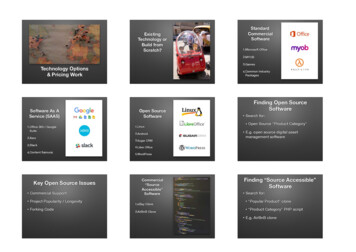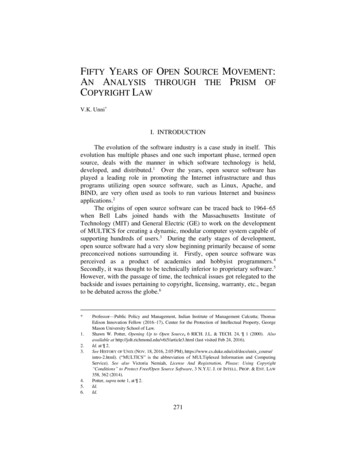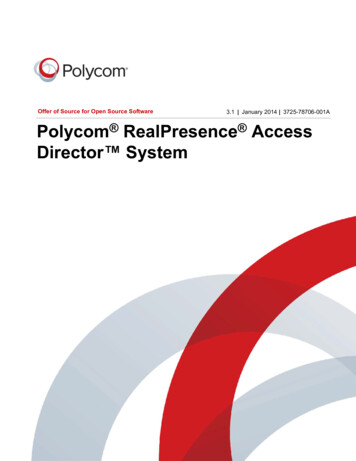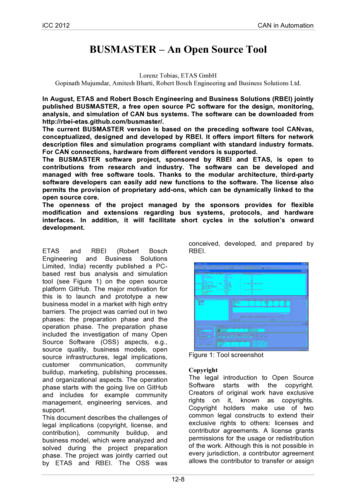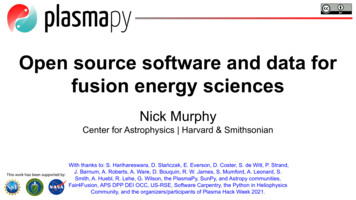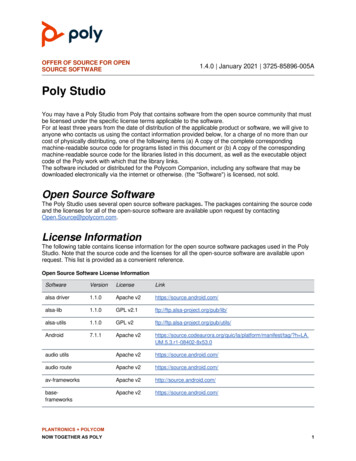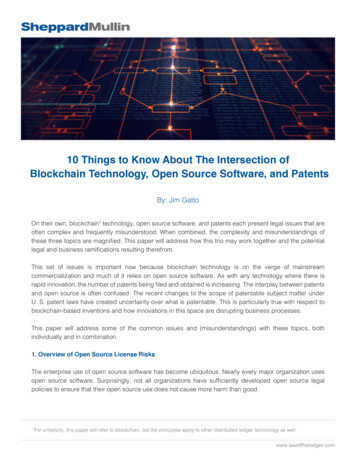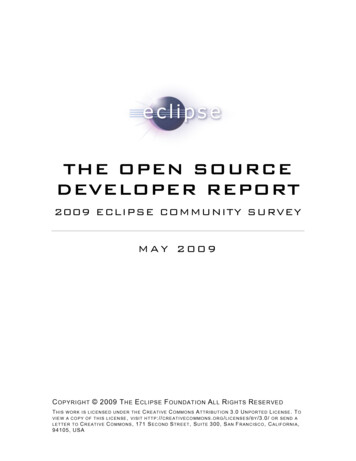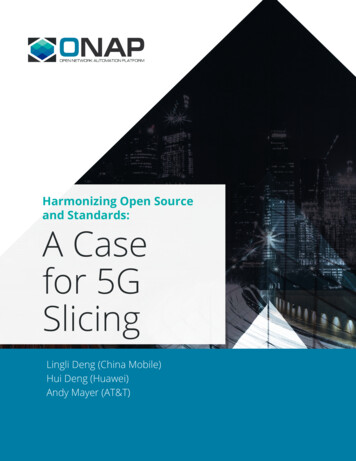
Transcription
Harmonizing Open Sourceand Standards:A Casefor 5GSlicingLingli Deng (China Mobile)Hui Deng (Huawei)Andy Mayer (AT&T)Harmonizing Open Source and Standards: A Case for 5G Slicing 1
1. INTRODUCTIONAs an operator-led open source community for a next generationnetwork automation platform, ONAP has been committed tothe convergence of standards and open source since inception,and has promoted cross-organizational industry cooperation bypublishing a series of white papers.Based on the latest version of ONAP Frankfurt, this latest article in the series focuses on solving thecore technical issues of the commercial vision of 5G slicing. It analyzes from an industry standardsperspective the existing situation of open source implementation and concludes with proposals forfuture work along this direction.Harmonizing Open Source and Standards: A Case for 5G Slicing 2
2. 5G SLICING VISIONNetwork slicing, as defined in the NGMN 5G white paper, refers to “A network slice, namely ’5G slice’, supportsthe communication service of a particular connection type with a specific way of handling the C- and U-planefor this service”. Its main purpose is to provide differentiated network services, using virtualization and othertechnologies to provide isolated end-to-end virtual private networks to meet the business needs of specificapplications and scenarios, and to ensure the SLA of the business. The basic framework of network slicing isshown in Figure 1:Figure 1 Basic framework and reference points for network slicingFrom the perspective of business requirements, network operators customize the design and provideslicing service products according to the needs of vertical industries, and monitor the operation statusof slicing services and related network resources through network management and control systems,and make real-time adjustments as needed to ensure that the Service Level Agreement (SLA) of the sliceservice meets user expectations. From the perspective of resource realization, the newly introducedend-to-end slice management system responds to customer needs by coordinating the correspondingmanagement plane functions to coordinate the corresponding physical or virtual network elements ofcontrol data planes and the physical or virtual link connection between them.Harmonizing Open Source and Standards: A Case for 5G Slicing 3
The main challenges in the current commercialization of end-to-end slicing services include: Automation: Automate slicing deployment, operation and maintenanceThe key to realizing the commercial value of the slice business is scale. On the one hand, operatorsneed to work hard to find and expand potential industry users, identify differences in their needs,and provide tailor-made services; on the other hand, they need to efficiently reuse the underlyingnetwork resources. The flexible provision of on-demand deployment, provisioning, and Operationsand Maintenance (O&M) management of virtual network slices based on a physical networkdepends on the high degree of automation of the entire slice management system. Cross-domain connection: coordinate the user planes, control planes and managementplanes of a wireless network, transmission network and core network.As 5G network slicing involves multiple domains such as User Equipment (UE), wireless network,transmission network, and core network, we need cross-domain collaboration to achieve completeend-to-end connection, management, operation, and maintenance. However, wireless, transmission,core network elements, networking methods, communication protocols, and managementand control methods are all very different. End-to-end management coordination may involvemultiple infrastructure providers or network operator Departments. The Standards DevelopmentOrganizations (SDOs) often only focus on some of these areas or technologies, and they lackcoordination with each other. SLA guarantee: Transform the needs of vertical industries into SLA slices and decomposethem into various domains to achieve real-time monitoring and dynamic guarantee.The transformation of vertical industry requirements (such as isolation, security, monitoring,bandwidth, delay, etc.) into network business indicators of the communications industry itselfinvolves cross-industry cooperation, and there are certain difficulties. Due to the differencesin implementation technologies in the wireless, transmission, and core network fields, how todecompose end-to-end service assurance indicators in various domains and how to cooperatebetween domains to achieve end-to-end assurance are still open issues. However, the scope ofthe work of traditional standardization organizations is limited to logical function descriptions andinteraction interface definitions, which cannot provide a clear solution to the above problems.Harmonizing Open Source and Standards: A Case for 5G Slicing 4
3. ONAP ModellingFigure 2 List of networking slicing related work progress of standard organizationAs shown in Figure 2, there are currently multiple standards organizations that research and definestandard specifications around network slicing. 3GPP is the focal point for 5G slicing Standards, whichare expected to be complementary with GSMA, TMF, IETF and CCSA. ONAP is working on a partialimplementation, with the purpose of achieving convergence with SDOs (starting with 3GPP).This next section will introduce the progress of slicing related work that typically includes organizationssuch as GSMA, 3GPP, IETF, CCSA, and ETSI.3.1 GSMAThe main goal of slicing is to provide differentiated services to meet the individual needs of differentbusinesses. The first problem in building end-to-end slicing is to clarify the specific requirements forcommunication services in different business scenarios. To this end, GSMA established the NetworkSlicing Taskforce (NEST) working group and released the NG.116 Generic Network Slice Template todescribe the characteristics of different types of slice services, corresponding to reference point 1 in Figure 1.NG.116 released the v2.0 version in October 2019, which includes 35 slice feature attributes, such asdelay, bandwidth, deterministic network, energy consumption, isolation, positioning, etc. The follow-upplan is further supplemented and improved.Harmonizing Open Source and Standards: A Case for 5G Slicing 5
3.2 3GPPIn 3GPP, there are several working groups involved in the standardization of slices. For example, SA1describes the use cases and requirements related to slices (Figure 1 reference point 1), SA5 defines theslice management architecture (Figure 1 reference points 2-9), Radio Access Network (RAN) defines thecharacteristics of support slices on the wireless side, SA2 defines the core network slice infrastructureand control plane processes, and SA3 defines the slice security features.3GPP SA2 and SA5 have planned to use the slice feature attributes defined in NG.116 as input to studyhow to convert user needs into mobile network requirements and finally reflect them on networkdeployment and O&M, corresponding to reference points 1 and 2 in Figure 1.Figure 3 3GPP network slice concept and management architecture3GPP SA5 further defines the slicing concept and slicing management architecture for the networkmanagement side as shown in Figure 3: Operators provide users with communication services (CSI 1, 2,3), which can be based on one or more network slice instances (NSI A, B, C).Network slice instances carry the business requirements of end-to-end slicing. The deploymentinformation is described by the associated Network Slice Subnet Instances (NSSI A, B, C). NSSI allowsnesting. As shown in the figure, an end-to-end NSSI can be composed of three sub-NSSIs: wireless,transmission, and core network NSSI. Corresponding to the management architecture, there are threelayers of functional entities: Communication Service Management Function (CSMF), Network SliceManagement Function (NSMF), and Network Slice Subnet Management Function (NSSMF). Among them,Harmonizing Open Source and Standards: A Case for 5G Slicing 6
CSMF manages communication services, NSMF manages NSI and its associated end-to-end NSSI, andNSSMF can deploy multiple entities according to technical domains. The entities are responsible for themanagement and orchestration of each inside NSSI of domains (wireless, transmission, core) respectively.Based on the above architecture, 3GPP SA5 defines a series of specifications related to network slicemanagement: TS28.530 specifies the management system and requirements for network slices.TS28.531 defines interfaces such as NSI / NSSI allocation / deletion. TS 28.541 specification defines thenetwork resource model for network slicing and the SLA requirements related for end-to-end slicingare described by ServiceProfile, and the deployment resource requirements for slicing subnets aredescribed by SliceProfile, covering parameters such as bandwidth, delay, and maximum UE number.3GPP SA2 defines the relevant architectures and procedures of core network element support slice inTS23.501, TS23.502.3GPP RAN defines the RAN side network slicing principles, slice selection, UE context processing,mobility and other signaling procedures in TS38.300.3.3 IETFThe IETF is mainly concerned with the management scheme of the transmission slice subnet. Currently,a design team is considering the design of the management model and interface between the 3GPPNSMF management system and the transmission slice management system, and the technologies,protocols and enhancements required for the transmission slice subnet.In addition, the IETF has developed many transport layer protocols, such as Segment Routing (SR),L3VPN, and the northbound interface of network controllers, such as the ACTN framework defined byRFC8453, which can be used to support slice deployment.3.4 ETSIETSI ZSM is positioned for cross-domain management automation use case requirements (ZSM001),reference architecture (ZSM002), and conducts in-depth research on the case of end-to-end slicingcross-domain management, and outputs the ZSM003 project document, which is based on the 3GPPslice management architecture, with reference to TMF open API for the north bound interface, and giveshow the wireless, transmission, core network and other management domains cooperate with ZSMcross-domain management to achieve end-to-end slice management processes.3.5 CCSACCSA is a regional standardization organization similar to ETSI in China. CCSA has newly established anad hoc working group on network slicing to formulate relevant standards for the basic functions andrequirements of slicing cross-domain interworking and the data plane interworking plan among thetransmission network, wireless network and the core network.Harmonizing Open Source and Standards: A Case for 5G Slicing 7
In addition, the TC7 working group in CCSA plans to formulate management systems, processes, modelsfor network slices with reference to 3GPP SA5 related specifications, and add enhanced functionssuch as template design on the basis. The TC5 working group has formulated a series of specificationsincluding YD / T 3615-2019, YD / T 3616-2019, YD / T 3618-2019, YD / T 3619-2019, etc. with reference tothe relevant specifications of 3GPP SA2 and RAN. These specifications formulated by TC5 define the corenetwork and wireless support network slicing functional requirements and related processes. The TC3and TC6 working groups plan to develop a northbound interface API for transmitting NSSMF to supportslice management in the TN domain.3.6 TM FORUMTM Forum is pursuing a generalized intent-based approach, where the clients of an API don’t need tounderstand the complexities of the resource layer but instead interact with the resource layer throughmore abstract capability features. Complementing this is the separation and mapping of the servicelayer abstraction, including service specifications and configurations (e.g., simplified slice templates), tothe resource layer, including resource function specifications and configurations (e.g., as described in3GPP’s 5G network resource model). The definition of a Connectivity Service Domain in TM Forum TR255allows 5G enabled services to be represented with a common service abstraction. In addition, TM ForumIG1194 entitled, Focus on Services Not Slices, proposes the hiding of network complexity by addingservice-aware constructs to the slice definitions. In TMF664, the Resource Function Activation andConfiguration API Specification, network slicing concepts such as: Network Slice, Network Slice Subnet,and 3GPP NRM managed functions are managed through an open API.3.7 MEF FORUMThe MEF Forum created Draft Standard MEF 22.3.1, Transport for 5G Mobile Networks. Support forNetwork Slicing in Carrier Ethernet Network (CEN) services can be accomplished using CEN servicesalready defined, combined with best fit Class of Service (CoS) and other service parameters. In this DraftStandard MEF considers the necessity of mapping the RAN Network Slice Identifier to the EthernetVirtual Connection (EVC) plus CoS by using the appropriate C-TAG VID (VLAN Identifier) PCP (PriorityCode Point) in the Ethernet Frame. Many Network Slices may be mapped to a single EVC. Such EVCs andrelated service parameters may be managed by using the MEF defined Lifecycle Service Orchestration(LSO) APIs.Harmonizing Open Source and Standards: A Case for 5G Slicing 8
4. ONAP REFERENCEIMPLEMENTATIONIn 2019, China Mobile united Tencent, and Huawei to demonstrate the ONAP D-version based 5Gend-to-end slice management prototype system for the first time at the ONS EU event, and formallyincorporated it into the community R & D plan in November 2019. This chapter will introduce therelated work schemes and analyze the corresponding standards from the three aspects of functionalarchitecture, model design, and implementation architecture.As shown in Figure 2, from the perspective of published standards, 3GPP SA5, GSMA, and TMF are thecore subjects for the formulation of the currently published slice management standards, so they arethe main targets of our benchmarking analysis.4.1 FUNCTIONS OVERVIEWThe ONAP Frankfurt version to be released in 2020 will include the open source referenceimplementations of CSMF and NSMF. Through northbound docking with industry customers andsouthbound docking with NSSMF, end-to-end slicing services and instances of full lifecycle managementand O&M monitoring will be implemented for three types of users:Operator business designers: based on in-depth understanding of the communication network andthe classification of industry customers’ needs, design end-to-end slicing templates, slicing businesstemplates by combining information from subnet slicing templates. Establish the mapping relationshipsbetween slicing business templates and the end-to-end slicing templates then encapsulate it into slicedproducts and publish them to the sliced mall.Operator network O&M engineers: they can monitor and manage the status of all running slicingservices, slicing networks, and subnet slicing instances; in addition, depending on the operator’sbusiness O&M needs, engineers may need to use the NSMF Portal manually to confirm / modifycandidate slice instances and candidate subnet slice instances (optional) recommended by the systemautomatically to respond to and process slice business orders from customers.Operator slicing business customers: purchase self-service slicing products through the slicing mallservice ordering interface, and activate and deactivate the slicing service in real time according to theirown time and space requirements, and terminate the service at any time. At the same time, during theentire lifecycle of the slicing business, enterprise customers can also monitor the real-time performanceindicators of the slicing business ordered in real time, which is convenient for enterprises to make timelyand flexible adjustments according to their own business needs.Harmonizing Open Source and Standards: A Case for 5G Slicing 9
4.2 MODEL DESIGNFigure 4 ONAP design state template and the corresponding relationship with the standardAs shown Figure 4, ONAP design mode provides four types of template design, which are: CST (Communication Service Template): Used to collect SLA requirements entered by usersfrom the Portal, which includes basic parameters for vertical industrial requirements. SD (Service Descriptor): It is used to record the user requirements collected by CST and convertthem to the network requirements understood by the management system, and apply for creatingan end-to-end slicing service instance based on this. NST (Network Slice Template): It is used to describe the deployment information of NSI, and isused to create new slice instances and / or subnet slice instances accordingly. NSST (Network Slice Subnet Template): used to deploy NSSI, describes the sub-domain networkslice and subnet capability information, and associates the virtual resource (NSD) informationrequired to deploy NSSI.Harmonizing Open Source and Standards: A Case for 5G Slicing 10
4.3 IMPLEMENTATION ARCHITECTUREFigure 5 Mapping between ONAP (Frankfurt) and 3GPP specificationsAs shown in Figure 5, the standard function mapping aspects are as follows: CSMF, corresponding to the SO, A&AI, and U-UI modules, implements the corresponding slice businesslifecycle management workflow, slice business instance information storage, and slice customerinteraction interface. NSMF, corresponding to the SO, A & AI, OOF module, and U-UI module, implements the slice instancelifecycle management workflow, slice instance mapping relationship storage, slice instance optimizationselection function implementation, and O&M user interface. Functions in SO module: The CSMF workflow collects user requirements through CST, generates S-NSSAI, and convertsthe original user requirements into network requirements understood by the managementsystem, records them in the ONAP business template, and applies to the NSMF workflow tocreate an end-to-end network slicing instance based on the SD. The NSMF workflow instantiates the Service Instance object according to the SD templateinformation, and maintains the relationship between the slice service identified by S-NSSAI andthe network slice instance (NSI).Harmonizing Open Source and Standards: A Case for 5G Slicing 11
Functions not involved in standards include: E2E slicing and slicing subnet design (including four types of templates), which are implemented by theSDC module. E2E slice indicator monitoring is implemented by the micro-services extended on DCAE by aggregatingthe underlying network element business indicators from NSSMF and reporting directly to themonitoring portal or northbound opening.Harmonizing Open Source and Standards: A Case for 5G Slicing 12
5. PROPOSALS FOR FUTURE WORKAt present, the concept of end-to-end 5G network slicing and the standard of the basic architecture havebeen basically mature. Open source practice has also been carried out in ONAP. It also provides a referencefor commercial deployment while verifying the standard. But in terms of the main challenges in thecommercialization of the slicing business, further work on standards and open source is still needed. Automation: There are many steps in the current network slicing deployment and operation andmaintenance that require manual intervention, and the degree of automation needs to be improved. Inthis regard, we can see that ONAP is already using a model-driven approach to attempt to automate theprocess of issuing and deploying slice services. Further work is needed to support the automation of theoperation and maintenance process. Cross-domain interworking: As can be seen from Figure 2, the current slice identification andimplementation technologies in the wireless, transmission, and core network domains are relativelymature, but in terms of cross-domain data plane interoperability, especially how to identify theconnection between the transmission and wireless and core networks and how to map slicesidentifications in each domain and how to manage cross-domain connections still require standardizedsolutions. At present, CCSA and other organizations are already discussing related cross-domaininterconnection schemes, and open source can further explore related practices. SLA assurance: SLA assurance includes the definition of SLA indicators, the decomposition of end-toend indicators into indicators in each domain, indicator monitoring, and dynamic guarantee. At present,in addition to SLA indicators supported by some standards, other aspects need to be further improved.Open source plans to develop and enhance the network slice monitoring function in the ONAP Guilinrelease, which will help promote this aspect of practice. In terms of definition of SLA indicators, it is necessary to clarify the performance, alarmindicators that can be supported by the wireless, transmission, and core network domains,and to associate them with end-to-end slicing. GSMA and 3GPP plan to further refine verticalindustry requirements and introduce them into slice information models. In terms of SLA indicator decomposition, 3GPP, CCSA and others plan to discuss to give specificsolutions on how each domain supports end-to-end SLA. In terms of SLA monitoring and protection, the current network element-based indicatorcollection, aggregation, and reporting mechanism has been relatively complete. It has alsobeen verified in ONAP. It can be enhanced on the basis of the current solution, expanding thefunctions of DCAE micro-services, and increasing required monitoring indicators or calculationmethods, and co-operate with modules such as Policy and Controller to realize the real-timeguarantee function of slice SLA.Harmonizing Open Source and Standards: A Case for 5G Slicing 13
In order to collectively address the above challenges, closer collaboration between SDOs andopen source communities is expected. On the one hand, open source focuses on improving the maturity and stability of core modules,as well as aligning standards using model artifacts. On the other hand, the SDOs are encouraged to build synergy on the basis of a model-driven platform: for organizations related to specific fields, such as 3GPP RAN, SA2, it isrecommended to continue to focus on the design of specific business functionmodules and interaction process design; for standard organizations that are positioned as end-to-end pull-through generalorchestration management platforms, such as ETSI ZSM, MEF LSO, etc. it isrecommended to design the functional architecture and interface specifications inaccordance with the model-driven approach of open source implementation.Harmonizing Open Source and Standards: A Case for 5G Slicing 14
6. LIST OF ACRONYMSAbbr.DescriptionAbbr.DescriptionA&AIActive and Available InventoryNSSINetwork Slice Subnet InstanceANAccess NetworkNSSMFNetwork Slice Subnet Management FunctionBSSBusiness Support SystemNSSTNetwork Slice Subnet TemplateCCSAChina Communication Standards AssociationNSTNetwork Slice TemplateCECustomer EdgeONAPOpen Networking Automation PlatformCENCarrier Ethernet NetworkOMCOperation and Maintenance CenterCNCore NetworkONSEUOpen Networking Summit EuropeCoSClass of ServiceOOFONAP Optimization FrameworkCSICommunication Service InstanceOSSOperation Support SystemsCSMFCommunication Service Management FunctionO&MOperation and MaintenanceCSTCommunication Service TemplatePCFPolicy Control FunctionCUcentralized unitPCPPriority Code PointDCAEData Collection, Analytics and EventsPEProvider EdgeDUdistributed unitRANRadio Access NetworkEMSElement Management SystemSDService DescriptorE2Eend to endSDCService Design and CreationETSIEuropean Telecommunications Standards InstituteSDNSoftware Defined NetworkEVCEthernet Virtual ConnectionSDOStandards Developing OrganizationgNBnext generation Node BSLAService Level AgreementGSMAGroupe Spécial Mobile AssociationSMFSession Management FunctionGSTGeneric Network Slice TemplateSOService OrchestratorIDIdentifierSRSegment RoutingIETFThe Internet Engineering Task ForceTMFTM ForumKPIKey Performance IndicatorTNTransport NetworkLSOLifecycle Service OrchestrationTSTechnical SpecificationL3VPNLayer 3 Virtual Private NetworkUDMUnified Data ManagementMANOManagement And OrchestrationUEUser EquipmentMEFMetro Ethernet ForumUPFUser Plane FunctionNESTNetwork Slicing TaskforceU-UIUse case User InterfaceNGMNNext Generation Mobile NetworksVIDVLAN identifierNSINetwork Slice InstanceZSMZero touch network & Service ManagementNSMFNetwork Slice Management Function3GPPThe 3rd Generation Partnership ProjectHarmonizing Open Source and Standards: A Case for 5G Slicing 15
Harmonizing Open Source and Standards: A Case for 5G Slicing 3 2. 5G SLICING VISION Network slicing, as defined in the NGMN 5G white paper, refers to "A network slice, namely '5G slice', supports the communication service of a particular connection type with a specific way of handling the C- and U-plane for this service".
